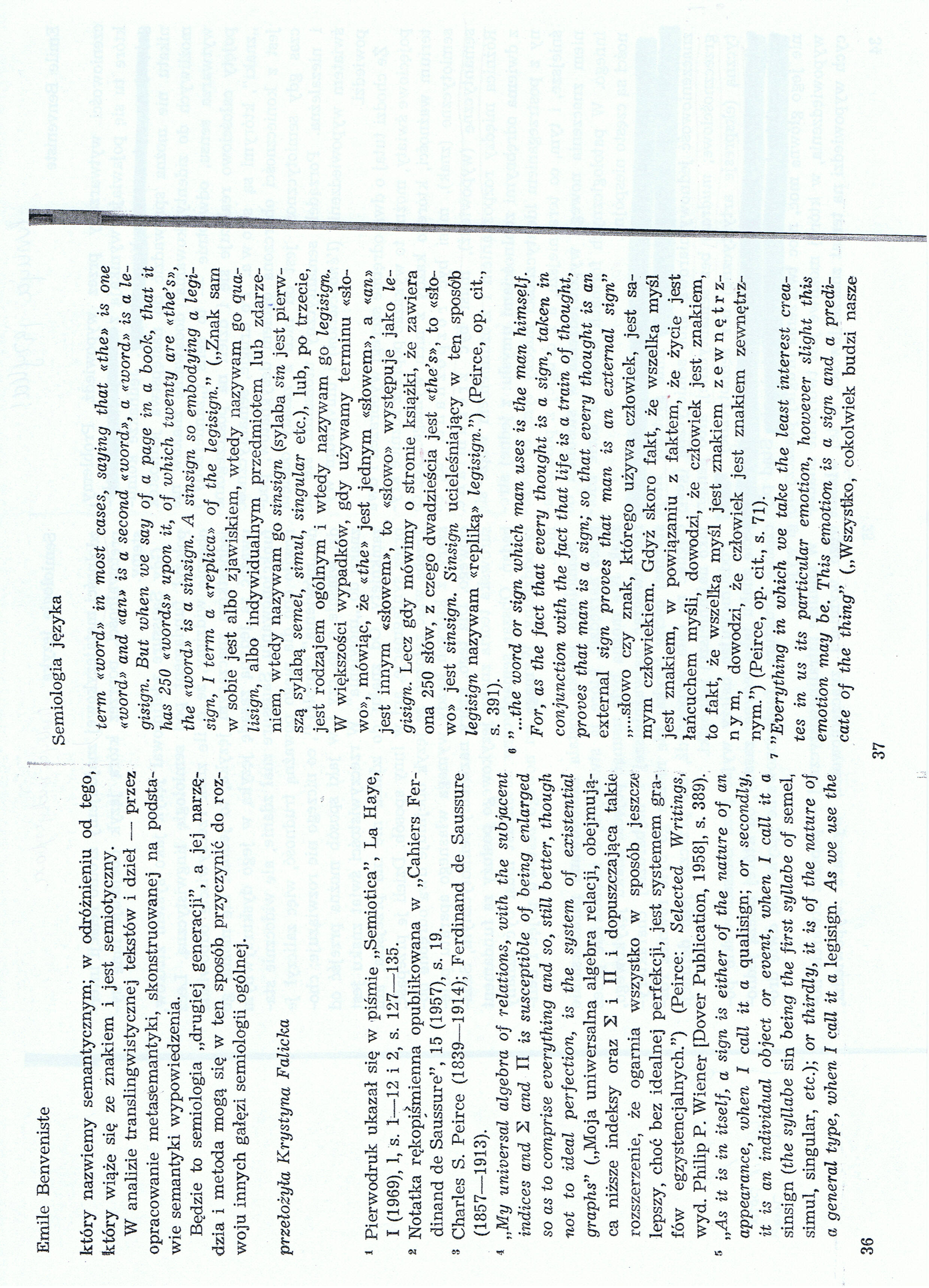Benveniste (12)

Emile Berweniste
który nazwiemy semantycznym; w odróżnieniu od tego, który wiąże się ze znakiem i jest semiotyczny.
W analizie translingwistycznej tekstów i dzieł — przez opracowanie metasemantyki, skonstruowanej na podstawie semantyki wypowiedzenia.
Będzie to semiologia „drugiej generacji”, a jej narzędzia i metoda mogą się w ten sposób przyczynić do rozwoju innych gałęzi semiologii ogólnej.
przełożyła Krystyna Falicka
1 Pierwodruk ukazał się w piśmie „Semiotica”, La Haye, I (1969), 1, s. 1—12 i 2, s. 127—135.
2 Notatka rękopiśmienna opublikowana w „Cahiers Fer-dinand de Saussure”, 15 (1957), s. 19.
3 Charles S. Peirce (1839—1914); Ferdinand de Saussure (1857—1913).
4 „My universał algebra of relations, with the subjacent
indices and 2 and II is susceptible of being enlarged so as to comprise everything and so, still better, though not to ideał perfection, is the system of existential graphs” („Moja uniwersalna algebra relacji, obejmująca niższe indeksy oraz 2 i II i dopuszczająca takie rozszerzenie, że ogarnia wszystko w sposób jeszcze lepszy, choć bez idealnej perfekcji, jest systemem grafów egzystencjalnych.”) (Peirce: Selected Writings,
wyd. Philip P. Wiener [Dover Publication, 1958], s. 389).
5 „As it is in itsełf, a sign is either of the naturę of an appearance, when I cali it a ąualisign; or secondly, it is an individual object or event, when I cali it a sinsign (the syllabe sin being the first syllabe of semel, simul, singular, etc.); or thirdly, it is of the naturę of a generał type, when I cali it a legisign. As we use the
Semiologia języka
term «word» in most cases, saying that «the» is one «word» and «an» is a second «word», a «word» is a le-gisign. But when we say of a page in a book, tliat it has 250 «words» upon it, of which tioenty are «the’s», the «word» is a sinsign. A sinsign so embodying a legi-sign, I term a «.replica» of the legisign.” („Znak sam w sobie jest albo zjawiskiem, wtedy nazywam go qua-lisign, albo indywidualnym przedmiotem lub zdarzeniem, wtedy nazywam go sinsign (sylaba sin jest pierwszą sylabą semel, simul, singular etc.), lub, po trzecie, jest rodzajem ogólnym i wtedy nazywam go legisign, W większości wypadków, gdy używamy terminu «sło-wo», mówiąc, że «the» jest jednym «słowem», a «an» jest innym «słowem», to «słowo» występuje jako legisign. Lecz gdy mówimy o stronie książki, że zawiera ona 250 słów, z czego dwadzieścia jest «the’s», to «sło-wo» jest sinsign. Sinsign ucieleśniający w ten sposób legisign nazywam «repliką» legisign.”) (Peirce, op. cit., s. 391).
6 ”...the word or sign which man uses is the man himsęlf. For, as the fact that every thought is a sign, taken in conjunction with the fact that life is a train of thought, proves that man is a sign; so that every thought is an external sign proves that man is an external sign” „...słowo czy znak, którego używa człowiek, jest samym człowiekiem. Gdyż skoro fakt, że wszelka myśl jest znakiem, w powiązaniu z faktem, że życie jest łańcuchem myśli, dowodzi, że człowiek jest znakiem, to fakt, że wszelka myśl jest znakiem zewnętrznym, dowodzi, że człowiek jest znakiem zewnętrznym.”) (Peirce, op. cit., s. 71).
7 ”Everything in which we taJce the least interest crea-tes in us its particular emotion, hovjever slight this emotion may be. This emotion is a sign and a predi-cate of the thing” („Wszystko, cokolwiek budzi nasze
37
Wyszukiwarka
Podobne podstrony:
skanuj0009 (325) — siła bodźca obojętnego, który staje się warunkowym. Jeżeli jest
skanuj0009 (325) — siła bodźca obojętnego, który staje się warunkowym. Jeżeli jest
IMGp20 (5) łatwo jest odróżnić biegnące w czterech kierunkach i krzyżujące się ze sobą linie, wzdłuż
page0048 40 a synem Rebeki. Rachel pobiegła natychmiast powie* dzieć to swemu bratu, który dowiedzia
KracauerCaligari�6 65 Okres powojenny swej woli człowiekowi, który staje się jego. narzędziem. Jest
IMGp20 (5) łatwo jest odróżnić biegnące w czterech kierunkach i krzyżujące się ze sobą linie, wzdłuż
img126 (12) 120 Backpropagatic a przekonasz się, że tak jest w istocie: najpierw przyrosty są niewie
skanuj0002 (110) 19. Epitop: a. jest regionem antygenu, który wi
skanuj0004 (54) 11. Fluktuacja to cykliczny typ dynamiki liczebności, który wiąże
Spostrzeganie - proces przetwarzania informacji, który wiąże się z odwzorowaniem
CCF20090225�051 VI PRZESTRZEŃ WIZUALNA Wzrok jest zmysłem, który rozwinął się na końcu i jest bez wą
CCF20100314�047 138 Zagadnienia poprawności leksykalno-semantycznej taty, w których tego nawiązania
więcej podobnych podstron